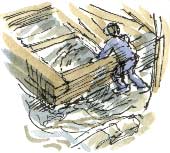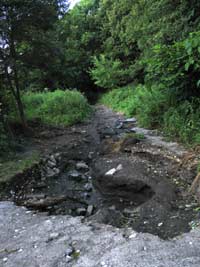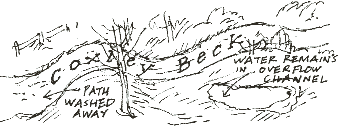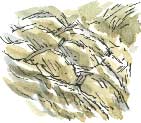| |
Coxley Valley after the Flood |
 AT
THE ENTRANCE to Coxley Valley, two men are working on a structure
that looks like a huge raft, partially launched into the stream. In fact it’s
the decking that appears in one of my photographs of the floods 6 weeks ago
(see 15th June). Undermined by flood erosion,
it is so solidly constructed, with an interlocking framework
of railway sleeper-sized hardwood,
that it needs dismantling before it can be moved.
AT
THE ENTRANCE to Coxley Valley, two men are working on a structure
that looks like a huge raft, partially launched into the stream. In fact it’s
the decking that appears in one of my photographs of the floods 6 weeks ago
(see 15th June). Undermined by flood erosion,
it is so solidly constructed, with an interlocking framework
of railway sleeper-sized hardwood,
that it needs dismantling before it can be moved.
 Hopefully
we won’t get another series of floods like those we had in June but,
if the beck’s recent history is anything to go by, the chances are that
this decking will be awash at some stage in the next five to ten years.
Hopefully
we won’t get another series of floods like those we had in June but,
if the beck’s recent history is anything to go by, the chances are that
this decking will be awash at some stage in the next five to ten years.
The
obstruction created by the new solid timber fence alongside the
stream-side path and the constriction in the stream's narrow floodplain caused
by the embankment that the new houses stand on will probably result in greater
erosion on this sharp bend in the course of the stream.
Overflow Channels
We picked our way along the eroded path (right), which reminds me
of a dry creek we walked down in Texas last year. The path, such as it is,
will soon be closed for reconstruction.

Further up the valley, above
the two small dams, which held during the the flood, you can
see where the beck has remodelled its channel.
A path on the downstream side of a bend has been
washed away while nearby a new pool has appeared, marking what was
evidently an overflow
channel.
The
stream looks so placid today that it's hard to imagine that it's capable
of such force in reshaping the valley.
Bedrock
 Even
at the top end of the valley the flow
was sufficient to scour away debris on the stream bed to reveal a
Even
at the top end of the valley the flow
was sufficient to scour away debris on the stream bed to reveal a  fresh-looking
exposure of the
bedrock, which here is sandstone (left). You
could previously see a part of this outcrop, but it wasn't as clean and extensive
as
it now is. I suspect the stream might have swept away any moss and liverwort
that
had
colonised
the rocks.
fresh-looking
exposure of the
bedrock, which here is sandstone (left). You
could previously see a part of this outcrop, but it wasn't as clean and extensive
as
it now is. I suspect the stream might have swept away any moss and liverwort
that
had
colonised
the rocks.
The
water table is evidently still high; at
New Hall Farm, a small pond has extended to become a ford
across the track (right). The resident family of mallards
evidently appreciate this.

Stocksmoor
 Stocksmoor
Common Yorkshire Wildlife Trust reserve is usually boggy
in places but today we found it impassable. The Trust has introduced highland
cattle to keep back
the encroaching silver birch from this rare example of semi-natural grassland
but the stout fence they’ve
erected means that it’s impossible to skirt around the boggy
sections of
footpath. The cattle were enjoying the shade of the woodland edge.
Stocksmoor
Common Yorkshire Wildlife Trust reserve is usually boggy
in places but today we found it impassable. The Trust has introduced highland
cattle to keep back
the encroaching silver birch from this rare example of semi-natural grassland
but the stout fence they’ve
erected means that it’s impossible to skirt around the boggy
sections of
footpath. The cattle were enjoying the shade of the woodland edge.
The main part of the reserve is now open access land and it’s
good to see wild flowers such as tormentil (and, if I'm right,
the similar cinquefoil) spreading amongst the tussocks, now that the grazing
has let more light in. Several species of dragonflies were
hovering and chasing over the pond, which was constructed not so long ago (within
the
last five or ten years) but which
blends into the landscape now that the marginal and aquatic vegetation has
become
established.
 Stinkhorn
Stinkhorn
 At
this time of year there’s always the carrion whiff of
stinkhorn wafting through Stoneycliffe Woods.
You can smell, but you don’t
often see, the fungus. At the top end of the valley we saw one growing right
next to path,
its glutinous spore-bearing head completely covered in black flies.
At
this time of year there’s always the carrion whiff of
stinkhorn wafting through Stoneycliffe Woods.
You can smell, but you don’t
often see, the fungus. At the top end of the valley we saw one growing right
next to path,
its glutinous spore-bearing head completely covered in black flies.
 AT
THE ENTRANCE to Coxley Valley, two men are working on a structure
that looks like a huge raft, partially launched into the stream. In fact it’s
the decking that appears in one of my photographs of the floods 6 weeks ago
(see 15th June). Undermined by flood erosion,
it is so solidly constructed, with an interlocking framework
of railway sleeper-sized hardwood,
that it needs dismantling before it can be moved.
AT
THE ENTRANCE to Coxley Valley, two men are working on a structure
that looks like a huge raft, partially launched into the stream. In fact it’s
the decking that appears in one of my photographs of the floods 6 weeks ago
(see 15th June). Undermined by flood erosion,
it is so solidly constructed, with an interlocking framework
of railway sleeper-sized hardwood,
that it needs dismantling before it can be moved. Hopefully
we won’t get another series of floods like those we had in June but,
if the beck’s recent history is anything to go by, the chances are that
this decking will be awash at some stage in the next five to ten years.
Hopefully
we won’t get another series of floods like those we had in June but,
if the beck’s recent history is anything to go by, the chances are that
this decking will be awash at some stage in the next five to ten years.
 Even
at the top end of the valley the flow
was sufficient to scour away debris on the stream bed to reveal a
Even
at the top end of the valley the flow
was sufficient to scour away debris on the stream bed to reveal a  fresh-looking
exposure of the
bedrock, which here is sandstone (left). You
could previously see a part of this outcrop, but it wasn't as clean and extensive
as
it now is. I suspect the stream might have swept away any moss and liverwort
that
had
colonised
the rocks.
fresh-looking
exposure of the
bedrock, which here is sandstone (left). You
could previously see a part of this outcrop, but it wasn't as clean and extensive
as
it now is. I suspect the stream might have swept away any moss and liverwort
that
had
colonised
the rocks.
 Stocksmoor
Common Yorkshire Wildlife Trust reserve is usually boggy
in places but today we found it impassable. The Trust has introduced highland
cattle to keep back
the encroaching silver birch from this rare example of semi-natural grassland
but the stout fence they’ve
erected means that it’s impossible to skirt around the boggy
sections of
footpath. The cattle were enjoying the shade of the woodland edge.
Stocksmoor
Common Yorkshire Wildlife Trust reserve is usually boggy
in places but today we found it impassable. The Trust has introduced highland
cattle to keep back
the encroaching silver birch from this rare example of semi-natural grassland
but the stout fence they’ve
erected means that it’s impossible to skirt around the boggy
sections of
footpath. The cattle were enjoying the shade of the woodland edge. Stinkhorn
Stinkhorn At
this time of year there’s always the carrion whiff of
stinkhorn wafting through Stoneycliffe Woods.
You can smell, but you don’t
often see, the fungus. At the top end of the valley we saw one growing right
next to path,
its glutinous spore-bearing head completely covered in black flies.
At
this time of year there’s always the carrion whiff of
stinkhorn wafting through Stoneycliffe Woods.
You can smell, but you don’t
often see, the fungus. At the top end of the valley we saw one growing right
next to path,
its glutinous spore-bearing head completely covered in black flies.